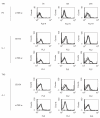The transmembrane form of TNF-alpha drives autoantibody production in the absence of CD154: studies using MRL/Mp-Fas(lpr) mice
- PMID: 12390309
- PMCID: PMC1906522
- DOI: 10.1046/j.1365-2249.2002.01982.x
The transmembrane form of TNF-alpha drives autoantibody production in the absence of CD154: studies using MRL/Mp-Fas(lpr) mice
Abstract
It is generally accepted that the interaction between CD40 and its ligand (CD154) plays a decisive role in contact-dependent help for T and B cells. In CD154-deficient MRL/Mp-Fas(lpr) (MRL/lpr) mice, however, high titres of IgG2a-type autoantibodies against small nuclear ribonucleoproteins (snRNPs) are observed. We successfully isolated two CD154-deficient MRL/lpr Th1 lines, which could provide B cell help for anti-snRNP antibody production. The proliferative responses of the Th1 cell lines were MHC class II (I-Ek)-restricted. Although syngeneic B cell proliferation was induced by Th1 lines in both a contact-dependent and -independent manner, the soluble form of TNF-alpha (sTNF-alpha) was not involved in contact-independent B cell proliferation. On the other hand, both anti-TNF-alpha and TNF-receptor 2 (TNF-R2, p75) monoclonal antibody (MoAb) blocked contact-dependent B cell proliferation, suggesting that the transmembrane form of TNF-alpha (mTNF-alpha)-TNF-R2 co-stimulation participates in B cell activation. Similarly, anti-TNF-alpha and TNF-R2 MoAb inhibited anti-snRNP antibody production in vitro, but anti-CD154 or TNF-R1 MoAb did not. These results indicate that the interaction of mTNF-alpha on activated Th1 cells with TNF-R2 on B cells may be involved in the autoimmunity seen in MRL mice, and that the blockade of CD40-CD154 co-stimulation may not always be able to suppress some Th1-related manifestations of lupus.
Figures




References
-
- Koh D-R, Ho A, Rahemutulla A, Fung-Leung W-P, Griesser H, Mak T-W. Murine lupus in MRL/lpr mice lacking CD4 or CD8 T cells. Eur J Immunol. 1995;25:2558–62. - PubMed
-
- Peng SL, Madaio MP, Hughes DPM, et al. Murine lupus in the antibodysence of αβ T cells. J Immunol. 1996;156:4041–9. - PubMed
-
- Chesnutt MS, Finck BK, Killeen N, Connolly MK, Goodman H, Wolfsy D. Enhanced lymphoproliferation and diminished autoimmunity in CD4-deficient MRL/lpr mice. Clin Immunol Immunopathol. 1998;87:23–32. - PubMed
Publication types
MeSH terms
Substances
LinkOut - more resources
Full Text Sources
Molecular Biology Databases
Research Materials
Miscellaneous

